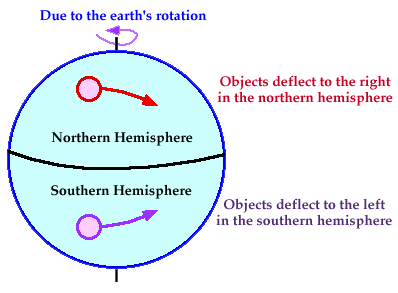Coriolis effect

Image courtesy Univ. of Illinois.
The Coriolis effect is an apparent deflection of the path of an object that moves within a rotating coordinate system; the object doesn't actually deviate from its path, but appears to do so because of the motion of the coordinate system. The Coriolis effect explains the directions of the trade winds in equatorial regions on Earth and, in general, plays a prominent part in studies of atmospheric dynamics of planets with dense atmospheres. It also figures in some aspects of ballistics, and astrophysics and stellar dynamics; for example, it is a controlling factor in the direction of rotation of sunspots. The effect, also known as the Coriolis force, is named after the French physicist Gaspard-Gustave de Coriolis (1792–1843).
The term Coriolis effect may also refer to the deflection of the flight path of a spacecraft caused by Earth's rotation. Over the northern hemisphere, the deviation is to the right; over the southern hemisphere, it is to the left.


